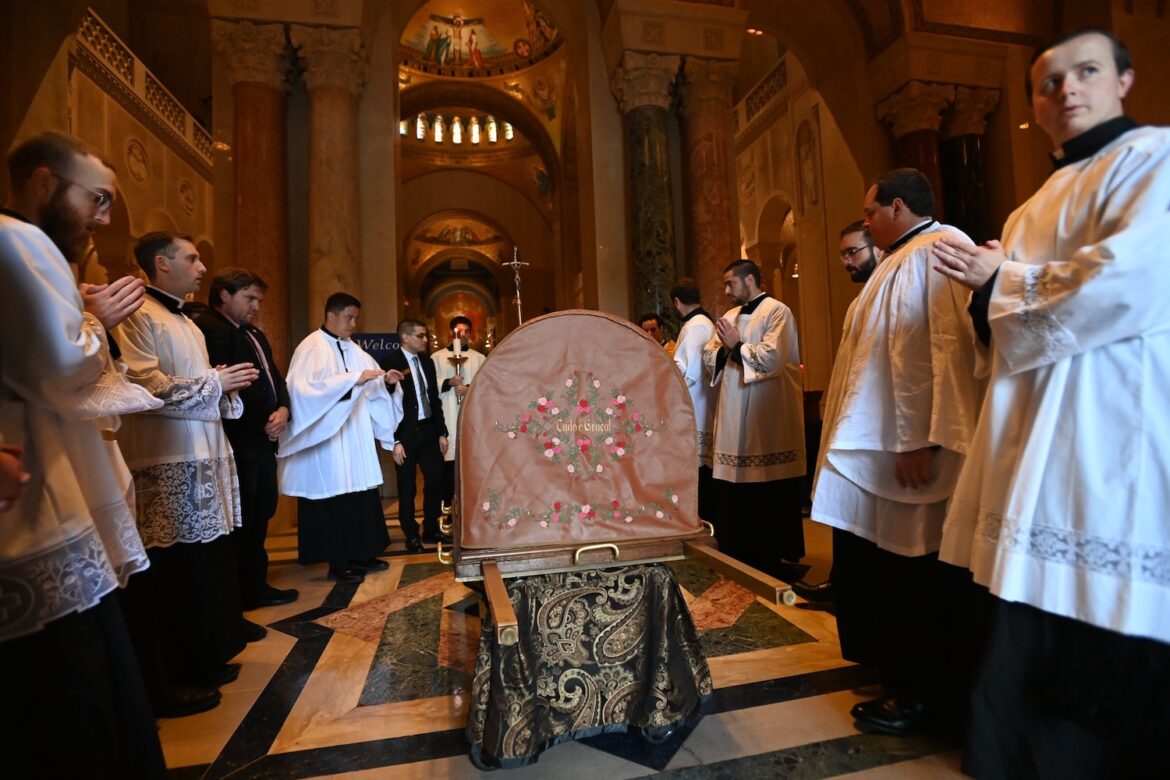WASHINGTON (OSV News) — A lot has happened to the United States since the last visit of the relics of St. Thérèse of Lisieux, during 1999-2000.
The collective national shock of the 9-11 terrorist attacks and ensuing War on Terror; disbelief when the Space Shuttle Columbia broke into pieces as it streaked across the Texas sky in 2003; the devastation of New Orleans by Hurricane Katrina in 2005; the 2008 financial crisis amid the 2007-2009 Great Recession; the stunned national mourning after the 2012 Sandy Hook Elementary School shooting, a scenario repeated many times since then; the world coming to a halt in the 2020 COVID-19 pandemic; the near assassination of President Donald Trump in 2024 and the assassination of conservative activist Charlie Kirk the following year are just some of the events that have left their mark on the country.
As St. Thérèse’s relics return to the U.S. Oct. 1 – Dec. 8, 2025, the country is in many ways changed. What do the plexiglass-enclosed bones of a 24-year-old French Carmelite nun who died in 1897 from tuberculosis have to say to a country that has been through so much?
Return to U.S.
On Nov. 19, those relics paused on a multi-city tour to rest at Catholic University’s Theological College in Washington. The next morning, they were escorted across a busy metro street by a phalanx of seminarians carrying candles and a crucifix, who reverently delivered St. Thérèse’s mortal remains to the Basilica of the National Shrine of the Immaculate Conception.
St. Thérèse’s relics were scheduled to remain at the basilica — the largest Catholic church in North America — until Nov. 22, when they journey on to the Carmel of Port Tobacco in La Plata, Maryland, site of the first Carmelite monastery in the original 13 U.S. states.
St. Thérèse (1873-1897) is most familiar to Catholics as a rose- and crucifix-clutching young woman with a sweet smile.
But those who have read her autobiography, “The Story of a Soul,” are also familiar with what is known as her “Little Way” — so-termed because of the words St. Thérèse herself who wrote: “I want to seek out a means of going to Heaven by a little way, a way that is very straight, very short, and totally new.”
This revolutionary Thérèsian spirituality — a spirituality that, on Nov. 20, attracted some 800 worshippers to morning prayer, Mass, and long lines just to spend a few seconds with her relics — is, like its young author, disarmingly simple: First, recognize our own weakness. Then, strive to grow in holiness. And finally — and perhaps most importantly — keep trusting in God’s mercy.
Learning ‘The Little Way’
“I think the Little Way she taught is perennially relevant,” Father Steven Payne, a Carmelite priest, professor of historical and systematic theology, and chair of Carmelite Studies at The Catholic University of America, told OSV News.
“It helps people today realize how they can aspire to holiness within their ordinary circumstances,” Father Payne, president of the Carmelite Institute of North America, continued. “The main thing people need to understand about the Little Way is that it’s all about confidence and love — not confidence in ourselves, but confidence in God’s mercy. Then we don’t have to be anxious all the time. We can trust in the Lord.”
As the line of faithful inched closer to the relics — ensconced behind the basilica’s altar rail, but close enough to reach; to touch — there was a hushed excitement. Some held roses — a nod to St. Thérèse’s nickname, “The Little Flower” and her promise to “let fall a shower of roses” after her death. A multitude of religious objects were touched to the domed cover enclosing the reliquary: rosaries; holy cards; statues.
Lauds, as morning prayer from the Liturgy of the Hours is known, was recited, followed by a “fervorino” (a short reflection) from Carmelite Father Simon Nolan.
“Her Little Way of trust — her confidence in God’s mercy — was nothing more, and nothing less, than the Gospel lived literally,” Father Nolan, prior of Whitefriar Street Church and Priory in Dublin and a lecturer in the Department of Philosophy at the National University of Ireland, told the visitors.
“People sometimes imagine that the shower of roses comes as miracles or dramatic favors,” he said. “But Thérèse’s shower of roses is first and always about love. Every time a soul begins to trust God more deeply, that is a rose. Every time a person forgives, instead of retaliating, that is a rose. Every time someone chooses hope, instead of despair, that is Thérèse’s promise, fulfilled.”
After recitation of the rosary, Mass was celebrated by Cardinal Wilton D. Gregory, the retired archbishop of Washington.
“Our veneration of Thérèse’s relics derives from our desire to capture some of the grace that led her to pursue God’s presence in such an extraordinary fashion,” Cardinal Gregory said in his homily. “Our religious veneration of the relics of the saints — as those of the Little Flower today — very much yearns for a share of those graces that animated Thérèse to inspire us to follow her Little Way of holiness to eternal life.”
There’s another purpose, too, he noted.
“Our spiritual veneration, actually, is a plea that God share with us some portion of the graces that made the saints so successful in holiness,” Cardinal Gregory said. “Catholics venerate the saints because we firmly believe that God has the power to transform us.”
Kimberley Heatherington is an OSV News correspondent.




